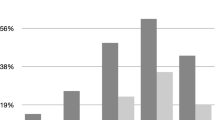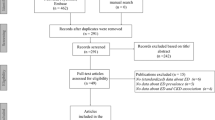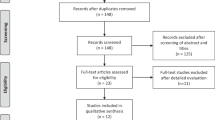Abstract
No previous studies have investigated the prevalence of latent tuberculosis infection (LTBI) among patients with erectile dysfunction (ED) or its contribution to the development of high-grade ED through a process of chronic inflammation-induced atherosclerosis. The aim of this study was to determine the frequency of LTBI among patients with erectile dysfunction and to explore the contribution of LTBI to high-grade ED. For all the study sample, clinical evaluation, imaging studies, and laboratory investigations were provided. Evaluation included, but was not confined to, scrotal ultrasonography, tuberculin skin test, and QuantiFERON-TB Gold test. The study sample mean ± SD age was 47.9 ± 13.6 years. Approximately 30% of the patients had LTBI and 43% had high-grade ED. After a multivariate analysis, it was found that older age (≥40 years) (OR, 5.2; 95% CI, 1.9–54.6; p 0.004), metabolic syndrome (MS) (OR, 3.4; 95% CI, 1.3–48.2; p 0.016), and LTBI (OR, 4.1; 95% CI, 1.7–61.3; p 0.021) were significantly, independently associated with high-grade ED as opposed to low-grade ED. In conclusion, the prevalence of LTBI among patients with high-grade ED is higher than among those with low-grade ED. In addition to LTBI, older age and MS are associated with high-grade ED as opposed to low-grade ED.
This is a preview of subscription content, access via your institution
Access options
Subscribe to this journal
Receive 8 print issues and online access
$259.00 per year
only $32.38 per issue
Buy this article
- Purchase on Springer Link
- Instant access to full article PDF
Prices may be subject to local taxes which are calculated during checkout

Similar content being viewed by others
References
National Institutes of Health. Consensus development conference statement. Impotence. December 7–9, 1992. Int J Impot Res. 1993;5:181–284.
Nicolosi A, Moreira ED, Jr, Shirai M, Bin Mohd Tambi MI, Glasser DB. Epidemiology of erectile dysfunction in four countries: cross-national study of the prevalence and correlates of erectile dysfunction. Urology. 2003;61:201–6.
Nicolosi A, Glasser DB, Kim SC, Marumo K, Laumann EO. GSSAB Investigators’ Group. Sexual behaviour and dysfunction and help-seeking patterns in adults aged 40-80 years in the urban population of Asian countries. BJU Int. 2005;95:609–14.
Shamloul R, Ghanem H. Erectile dysfunction. Lancet. 2013;381:153–65.
Ponholzer A, Gutjahr G, Temml C, Madersbacher S. Is erectile dysfunction a predictor of cardiovascular events or stroke? A prospective study using a validated questionnaire. Int J Impot Res. 2010;22:25–9.
Chung SD, Chen YK, Lin HC, Lin HC. Increased risk of stroke among men with erectile dysfunction: a nationwide population-based study. J Sex Med. 2011;8:240–6.
Cheng JY, Ng EM. Body mass index, physical activity and erectile dysfunction: an U-shaped relationship from population-based study. Int J Obes. 2007;31:1571–8.
Dong JY, Zhang YH, Qin LQ. Erectile dysfunction and risk of cardiovascular disease: meta-analysis of prospective cohort studies. J Am Coll Cardiol. 2011;58:1378–85.
Kulchavenya E, Scherban M, Brizhatyuk E, Osadchiy A. Sexual dysfunction in male patients with pulmonary tuberculosis. J Microbiol Infect Dis. 2012;2:124–6.
O’Garra A, Redford PS, McNab FW, Bloom CI, Wilkinson RJ, Berry MP. The immune response in tuberculosis. Annu Rev Immunol. 2013;31:475–527.
Salgame P, Geadas C, Collins L, Jones-López E, Ellner JJ. Latent tuberculosis infection--Revisiting and revising concepts. Tuberculosis. 2015;95:373–84.
Turetz ML, Ma KC. Diagnosis and management of latent tuberculosis. Curr Opin Infect Dis. 2016;29:205–11.
Mazurek GH, Jereb J, Vernon A, LoBue P, Goldberg S, Castro K, et al. Updated guidelines for using Interferon Gamma Release Assays to detect Mycobacterium tuberculosis infection - United States, 2010. MMWR. Recomm Rep. 2010;59:1–25.
Menzies D, Pai M, Comstock G. Meta-analysis: new tests for the diagnosis of latent tuberculosis infection: areas of uncertainty and recommendations for research. Ann Intern Med. 2007;146:340–54.
Huaman MA, Henson D, Ticona E, Sterling TR, Garvy BA. Tuberculosis and cardiovascular disease: linking the epidemics. Trop Dis Travel Med Vaccines. 2015;1:10.
George J, Shoenfeld Y, Afek A, Gilburd B, Keren P, Shaish A, et al. Enhanced fatty streak formation in C57BL/6J mice by immunization with heat shock protein-65. Arterioscler Thromb Vasc Biol. 1999;19:505–10.
Lamb DJ, El-Sankary W, Ferns GA. Molecular mimicry in atherosclerosis: a role for heat shock proteins in immunisation. Atherosclerosis. 2003;167:177–85.
Rosen RC, Cappelleri JC, Smith MD, Lipsky J, Peña BM. Development and evaluation of an abridged, 5-item version of the International Index of Erectile Function (IIEF-5) as a diagnostic tool for erectile dysfunction. Int J Impot Res. 1999;11:319–26.
Shamloul R, Ghanem H, Abou-zeid A. Validity of the Arabic version of the sexual health inventory for men among Egyptians. Int J Impot Res. 2004;16:452–5.
Howard A, Mercer P, Nataraj HC, Kang BC. Bevel-down superior to bevel-up in intradermal skin testing. Ann Allergy Asthma Immunol. 1997;78:594–6.
Expert Panel on Detection, Evaluation, and Treatment of High Blood Cholesterol in Adults. Executive summary of the third report of the national cholesterol education program (NCEP) expert panel on detection, evaluation, and treatment of high blood cholesterol in adults (adult treatment panel III). JAMA. 2001;285:2486–97.
Faul F, Erdfelder E, Lang AG, Buchner A. G*Power 3: a flexible statistical power analysis program for the social, behavioral, and biomedical sciences. Behav Res Methods. 2007;39:175–91.
Zügel U, Kaufmann SH. Activation of CD8 T cells with specificity for mycobacterial heat shock protein 60 in Mycobacterium bovis bacillus Calmette-Guérin-vaccinated mice. Infect Immun. 1997;65:3947–50.
Shoenfeld Y, Sherer Y, Harats D. Atherosclerosis as an infectious, inflammatory and autoimmune disease. Trends Immunol. 2001;22:293–5.
Stöllberger C, Finsterer J. Role of infectious and immune factors in coronary and cerebrovascular arteriosclerosis. Clin Diagn Lab Immunol. 2002;9:207–15.
Fong IW. Emerging relations between infectious diseases and coronary artery disease and atherosclerosis. CMAJ. 2000;163:49–56.
Hoffmeister A, Rothenbacher D, Bode G, Persson K, März W, Nauck MA, et al. Current infection with Helicobacter pylori, but not seropositivity to Chlamydia pneumoniae or cytomegalovirus, is associated with an atherogenic, modified lipid profile. Arterioscler Thromb Vasc Biol. 2001;21:427–32.
Shah PK. Link between infection and atherosclerosis: who are the culprits: viruses, bacteria, both, or neither? Circulation. 2001;103:5–6.
Xu Q, Kiechl S, Mayr M, Metzler B, Egger G, Oberhollenzer F, et al. Association of serum antibodies to heat-shock protein 65 with carotid atherosclerosis: clinical significance determined in a follow-up study. Circulation. 1999;100:1169–74.
Zhu J, Quyyumi AA, Rott D, Csako G, Wu H, Halcox J, et al. Antibodies to human heat-shock protein 60 are associated with the presence and severity of coronary artery disease: evidence for an autoimmune component of atherogenesis. Circulation. 2001;103:1071–5.
Lamb DJ, Ferns GA. The magnitude of the immune response to heat shock protein-65 following BCG immunisation is associated with the extent of experimental atherosclerosis. Atherosclerosis. 2002;165:231–40.
Perschinka H, Mayr M, Millonig G, Mayerl C, van der Zee R, Morrison SG, et al. Cross-reactive B-cell epitopes of microbial and human heat shock protein 60/65 in atherosclerosis. Arterioscler Thromb Vasc Biol. 2003;23:1060–5.
Rota S, McWilliam NA, Baglin TP, Byrne CD. Atherogenic lipoproteins support assembly of the prothrombinase complex and thrombin generation: modulation by oxidation and vitamin E. Blood. 1998;91:508–15.
Jastrzębska S, Walczak-Jędrzejowska R, Kramek E, Marchlewska K, Oszukowska E, Filipiak E, et al. Relationship between sexual function, body mass index and levels of sex steroid hormones in young men. Endokrynol Pol. 2014;65:203–9.
Russo GI, Cimino S, Fragalà E, Privitera S, La Vignera S, Condorelli R, et al. Insulin resistance is an independent predictor of severe lower urinary tract symptoms and of erectile dysfunction: results from a cross-sectional study. J Sex Med. 2014;11:2074–82.
Kelly DM, Nettleship JE, Akhtar S, Muraleedharan V, Sellers DJ, Brooke JC, et al. Testosterone suppresses the expression of regulatory enzymes of fatty acid synthesis and protects against hepatic steatosis in cholesterol-fed androgen deficient mice. Life Sci. 2014;109:95–103.
Contreras C, Sánchez A, Martínez P, Climent B, Benedito S, García-Sacristán A, et al. Impaired endothelin calcium signaling coupled to endothelin type B receptors in penile arteries from insulin-resistant obese Zucker rats. J Sex Med. 2013;10:2141–53.
Author contributions
A.F.A.H.: Concepts, design, definition of intellectual content, literature search, clinical studies, data acquisition, data analysis, statistical analysis, manuscript preparation, manuscript editing, and guarantor. A.M.A.M. and A.S.S.: Literature search, clinical studies, data acquisition, and manuscript review. A.M.A.N.: Definition of intellectual content, experimental studies, data acquisition, and manuscript editing. A.A.H.Z.: literature search, clinical studies, data acquisition, data analysis, and manuscript editing. S.M.A.-A.: Data acquisition. S.M.B.: Experimental studies, data acquisition, and manuscript review. A.E.I.A.: Statistical analysis, manuscript preparation, manuscript editing, and manuscript review.
Author information
Authors and Affiliations
Corresponding author
Ethics declarations
Conflict of interest
The authors declare that they have no competing interests.
Additional information
Publisher’s note
Springer Nature remains neutral with regard to jurisdictional claims in published maps and institutional affiliations.
Rights and permissions
About this article
Cite this article
Hasanain, A.F.A., Mahran, A.M.A., Safwat, A.S. et al. Latent tuberculosis infection among patients with erectile dysfunction. Int J Impot Res 30, 36–42 (2018). https://doi.org/10.1038/s41443-017-0004-4
Received:
Revised:
Accepted:
Published:
Issue Date:
DOI: https://doi.org/10.1038/s41443-017-0004-4



